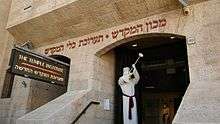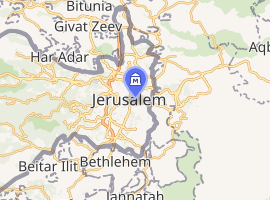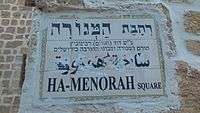The Temple Institute
The Temple Institute, known in Hebrew as Machon HaMikdash (Hebrew: מכון המקדש), is an organization in Israel focusing on the endeavor of establishing the Third Temple. Its long-term aims are to build the third Jewish temple on the Temple Mount, on the site currently occupied by the Dome of the Rock, and to reinstate animal sacrificial worship. It aspires to reach this goal through the study of Temple construction and ritual and through the development of actual Temple ritual objects, garments, and building plans suitable for immediate use in the event conditions permit its reconstruction.[1] It runs a museum in the Jewish Quarter of the Old City of Jerusalem in Israel.[2] It was founded and is headed by Rabbi Yisrael Ariel.[3] Its current Director General is Dovid Shvartz, and the International Department is headed by Rabbi Chaim Richman. New York billionaire Henry Swieca has supported the institute.[4] The Israeli government has also provided funding.[5][6]
 | |

| |
| Established | 1987 |
|---|---|
| Location | Jerusalem |
| Website | www |
Activities
Building of Temple ritual items
| Item | Purpose |
|---|---|
| Copper laver | For Kohanim to wash at start of day |
| Mizrak | Holds blood from sacrificial animals |
| Large mizrak | Holds blood from larger animals |
| Three-pronged fork | To arrange offerings on the altar |
| Measuring cup | To measure meal offerings |
| Copper vessel for meal offerings | To prepare meal offerings |
| Silver shovel | To remove ashes from the altar |
| Silver vessel for wine libation | For wine accompanying offerings |
| Lottery box | For Yom Kippur |
| Silver altar cup for water libation | For Sukkot |
| Silver libation vessels | For Sukkot |
| Sickle | To reap the Omer barley |
| Other offering implements | To offer the Omer barley |
| Abuv | To roast the Omer barley |
| Menorah cleansing vessel | To clean the Menorah |
| Oil pitcher | For replenishing the Menorah |
| Small golden flask | For replenishing individual Menorah lamps |
| Frankincense censer | |
| Incense chalice | For Ketoret or incense offering |
| Incense shovel | For Ketoret or incense offering |
| Menorah | See Menorah. |
| Table of the Showbread | See Showbread. |
| Incense altar | For Ketoret or incense offering |
| Ark of the Covenant (mock up) | See Ark of the Covenant. |
| Crown | Crown worn by the High Priest |
| Garments of the High Priest | See High Priest. |
| Silver trumpets | Announce special occasions and offerings |
| Gold-plated shofar | For Rosh Hashanah. See Shofar. |
| Silver-plated shofar | For fast days. See Shofar. |
| Harp | Used by the choir of Levites singing psalms |
| Lyre | Used by the choir of Levites singing psalms |
As part of its ongoing effort to prepare for a future rebuilt Temple, the Temple Institute has been preparing ritual objects suitable for Temple use. Many of the over ninety ritual items to be used in the Temple have been made by the Temple Institute.
As of June 2008, a major current project of the institute is the creation of the sacred uniform of the Kohen Gadol, the High Priest, and the ordinary priests. This project, the culmination of years of study and research, has been underway for several years. The High Priest's Hoshen (breastplate) and Ephod have already been completed. The Tzitz, the golden crown of the High Priest, was completed in 2007. The Temple Institute is designing the garments for the lay priests intended for purchase by Kohanim.
Education programs
The institute's educational efforts include raising public awareness about the Holy Temple, and the central role that it is believed to occupy in the spiritual life of mankind. These efforts include a full-time research staff (kollel), seminars, publications, and conferences, as well as the production of educational materials. Online educational tools include the Institute's website , educational videos and video conferencing.
Red heifer
In addition to a variety of items required for service within the Temple, the institute has attempted to locate a parah adumah (red heifer) consistent with the requirements of Numbers 19:1–22 and Mishnah Tractate Parah for purposes of taharah (purification) necessary to enter the Temple sanctuary proper in most circumstances.[8][9] In recent years, the institute identified two candidates, one in 1997 and another in 2002.[10] The Temple Institute had initially declared both kosher, but later found each to be unsuitable.
Controversies
Rebuilding a Jewish temple on the Temple Mount


Although Orthodox Judaism generally agrees that the Temple in Jerusalem will and should be rebuilt, there is a substantial disagreement about whether this should occur by human or divine hands. The Temple Institute interprets the opinion of the Rambam (Maimonides) as saying that Jews should attempt to build the Temple themselves, and have a mitzvah (obligation) to do so if they can. The Rambam's opinion, however, is a controversial one and has aroused substantial opposition.
The Temple Institute's view of the Rambam's opinion is not universally accepted by Maimonides scholars. According to seventeenth-century Rabbi Yom Tov Lipman Heller in his commentary on the tractate Yoma, the Rambam did not say that any Jew can build the future Temple, only the Messiah.
Ascending the Temple Mount
The rabbis associated with the Temple Institute hold (also following the Rambam) that it is, under certain conditions, permissible under Jewish law for Jews to visit parts of the Temple Mount and periodically organize groups to ascend and tour the Mount. The view that Jews may ascend the Temple is controversial among Orthodox rabbis, with many authorities completely prohibiting visiting the Mount to prevent accidental entrance into and desecration of the Holy of Holies or other sacred, off-limits areas.
The Temple Institute conducts aliyot (literally, "ascending"; "making a pilgrimage") to the Temple Mount. The institute claims that these aliyot are conducted in accordance with halachic requirements.
See also
- The Third Temple
- Modern attempts to revive the Sanhedrin
- Temple Mount
References and footnotes

- "A House of Prayer for All Nations" Jerusalem Post, October 11, 2005
- Wright, Lawrence. "Forcing the End: Why do Pentecostal cattle breeder from Mississippi and an Orthodox Rabbi from Jerusalem believe that a red heifer can bring change?". Frontline at PBS. Retrieved 11 July 2014.
The Temple Institute operates a small museum in the Jewish Quarter of the Old City.
- Rebuild Herod's Temple? A Few Israelis Hope The New York Times, April 9, 1989.
- Booth, William; Eglash, Ruth (December 2, 2013). "Jewish activists want to pray on Jerusalem's Temple Mount, raising alarm in Muslim world". The Washington Post. Retrieved August 15, 2016.
The project was funded by Henry Swieca, the billionaire American investor, and his wife, Estee.
- Tobin, Andrew (August 12, 2016). "The third Jewish Temple is coming to your Facebook feed". Jewish Telegraphic Agency. Retrieved August 15, 2016.
The Israeli government provides some funding to the Temple Institute — though not reliably or significantly, according to its directors — as it does educational and research institutions, and allows women to do their national service as tour guides at its exhibition.
- "Report: State funds groups that advocate building Third Temple". The Jerusalem Post. April 8, 2013. Retrieved August 15, 2016.
Over the course of the last decade, the Education Ministry and the Culture and Sport Ministry have transferred between NIS 300,000 and 700,000 to a non-government organization known as The Temple Institute. Just last year, the group received NIS 282,000 from the Education Ministry and another NIS 134,000 from the Culture Ministry.
- http://www.templeinstitute.org/vessels_gallery.htm
- http://www.templeinstitute.org/red_heifer/red_heifer_contents.htm Temple Institute: Red Heifer
- "Apocalypse Cow". The New York Times. March 30, 1997. Retrieved December 21, 2013.
- Red Heifer born in Israel Temple Institute, 8 April 2002
External links
| Wikimedia Commons has media related to The Temple Institute. |